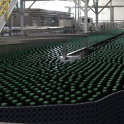|
How come using yeast strains that give up early on fermentation doesn't seem to be a big thing in cider? I would have thought it you loaded up on malt extract and sugar, and had a yeast that didn't like too much alcohol you'd have a fair amount of residual sweetness.
|
|
|
|

|
| # ? Apr 26, 2024 14:39 |
|
ChickenArise posted:Use juice or concentrate instead of simple syrup, and it's even better. This post made me check the abv of my ciders. 9.5%. Lord in heaven. It doesn't sound huge but I tasted them yesterday and well... I just hope no one gets hurt. It's a touch boozy, but not that much. They are quite young too, 2.5 weeks. Which also begs another question. Both the 4766 and Champagne yeast ciders going have a really strong sulfur aroma. My guess was that it was just like any lager, it'll dissipate eventually. I assume this gasses off, yes? Nanpa posted:How come using yeast strains that give up early on fermentation doesn't seem to be a big thing in cider? I would have thought it you loaded up on malt extract and sugar, and had a yeast that didn't like too much alcohol you'd have a fair amount of residual sweetness. Just for me, I wanted to back sweeten and get everything out of the apples/sugar as I could. Plus, it'd be tough to find a yeast that would just give up with an OG of 1.074 and easily edible sugars.
|
|
|
|
hellfaucet posted:Wow. I assume she'd press charges.
|
|
|
|
Has anyone ever made a kellerbier? I brewed 6 gallons of a Munich dunkel last weekend and I'm thinking about bottling half of it right after primary as a sort-of dunkel kellerbier. I've read a few articles on the style and some of them say not to prime it and serve it flat but I think I would just give it a small amount of carbonation, maybe 1.3-1.8 volumes. Should I try it or am I basically throwing away half a batch of beer by doing this?
|
|
|
|
Nanpa posted:How come using yeast strains that give up early on fermentation doesn't seem to be a big thing in cider? I would have thought it you loaded up on malt extract and sugar, and had a yeast that didn't like too much alcohol you'd have a fair amount of residual sweetness. I've not made a cider with malt extract in it, just juice and sugar or honey. And the fact is that those things don't have the long saccharides that malt does, so it's pretty much all fermentable. Even when I've done a pound of honey per gallon of juice (which makes a product over 12% ABV, if I recall correctly), it ferments down pretty low. And actually, I do use less-attenuative yeast - that's why the Sweet Mead strain makes a good product. If I had done that with Champagne yeast, it would have been even higher ABV and dry enough to crack your teeth.
|
|
|
|
I can attest to the champagne yeast being beastly. My cider was wicked dry when it was done, something like .996. I thought it tasted pretty good and surprisingly not boozy for 13%, but there was no way my room mates or friends would be into it that dry, so I had to hit it with campden and k-sulfate then back sweeten with turbidino (sp?) sugar to around 1.002. Now it's everyone's favorite tap.
|
|
|
|
Not going to try to push it then. Will make it next fall. Already have enough things on tap that it will hardly make a difference. Honestly looking forward to this party just as a means of emptying a few kegs to make room for new things-- brewing more than I can drink.
|
|
|
|
Doing my first solo all-grain tomorrow on our system. I'm worried about a few things, namely getting the strike temperature right when mashing, I have no idea how much it will change from being poured to the malt adding. Is there anything I can do if it's too low or too high or do I simply have to deal with it? I know if it's too high it will halt conversion and I won't be getting the water too hot anyway, but say it goes below 150 for some reason, is there anything we can do to salvage it? Other than that I think it'll be hard to mess up, I just hope our mash tun drains off nicely.
|
|
|
|
Nanpa posted:How come using yeast strains that give up early on fermentation doesn't seem to be a big thing in cider? I would have thought it you loaded up on malt extract and sugar, and had a yeast that didn't like too much alcohol you'd have a fair amount of residual sweetness. If you add malt extract instead of sugar it's easier to get some good residual sweetness, though it will take it away from a pure apple flavor too. And if you're going the route of stocking up with LME and yeast nutrient and other things rather than just putting juice in a bucket, it's also useful to add some tannin when you're dealing with juice apples: there's usually less of those there than in an apple meant for hard cider, and adding some helps to balance tartness.
|
|
|
|
Killer robot posted:it's also useful to add some tannin when you're dealing with juice apples: there's usually less of those there than in an apple meant for hard cider, and adding some helps to balance tartness. Yep, I have a book I bought long ago about cider, and it talks in terms of a balanced blend of apples (mostly varieties that are not very common anymore, or at least not here in SoCal) and hundred-year-old orchards and all that. To be clear, the cider I make is hardly prize-winning stuff, but it's cheap, fun, and fast to make, and it satisfies those I know who don't really care for beer.
|
|
|
|
Midorka posted:Doing my first solo all-grain tomorrow on our system. I'm worried about a few things, namely getting the strike temperature right when mashing, I have no idea how much it will change from being poured to the malt adding. Is there anything I can do if it's too low or too high or do I simply have to deal with it? I know if it's too high it will halt conversion and I won't be getting the water too hot anyway, but say it goes below 150 for some reason, is there anything we can do to salvage it? First off you can mash anywhere from 146-158*F depending on what you're going for, so it's pretty hard to miss your temp by so much that you don't get conversion. Use an online strike temperature calculator, it will ask for the temperature of the grain and the amount of water you'll be using and will tell you what temp your water should be at to hit your desired temp range. Keep a half gallon or gallon of boiling water in a seperate pot. If your strike temp is too low, add boiling water to raise it. If it's too high add cold water to lower it. Stir thoroughly after adding water and take temps in multiple places to make sure you're getting an accurate reading. Nothing too bad can happen, if you mash too low conversion takes longer and your FG will be lower, if you mash too high you'll have more residual sugars left and a higher FG. Not really a big deal either way.
|
|
|
|
Josh Wow posted:First off you can mash anywhere from 146-158*F depending on what you're going for, so it's pretty hard to miss your temp by so much that you don't get conversion. Use an online strike temperature calculator, it will ask for the temperature of the grain and the amount of water you'll be using and will tell you what temp your water should be at to hit your desired temp range. Thanks for the advice, will be trying it tomorrow when we finally brew our ESB. Also two weeks ago me and my buddies brewed one of those low ABV kits it said we should expect a FG of 1.010 from 1.040 OG once fermentation was done we hit 1.010. We then dry hopped it and a few days later added oak chips. The gravity is now 1.002 and there are alcohol fumes coming up from it. It smells and tastes like a fruity dry white wine. Did adding oak chips, we sanitized them by toasting, or adding hops potentially do anything to increase the ABV or were we just premature in measuring the FG?
|
|
|
|
Midorka posted:Thanks for the advice, will be trying it tomorrow when we finally brew our ESB. A really low gravity like 1.002 probably means a brettanomyces or other wild yeast infection (unless you used something like a saison yeast at 90 degrees or something). Hops are naturally resistant to wild yeasts and bugs growing on them, but oak chips are not; my assumption would be that the oak chips were not fully sanitized, although I'm just speculating on that point. Beer producing yeast typically does not ferment down to that level. (1.010 seems like a fairly low FG for a mild, actually) Angry Grimace fucked around with this message at 00:39 on Oct 19, 2012 |
|
|
|
The kit said it would finish at 1.010, it was a dry yeast packet we didn't rehydrate or anything. I stressed to my buddy to toast the chips at 350 for an hour and he said he did. The beer does taste really fruity with dry white wine so I'm not sure. We fermented at 66-70 and pitched at 68. I suppose there is a chance it got infected somehow but we've been pretty cautious about sanitation so I don't know. The original gravity was 1.040, in-case you missed it. Edit: I thought beer was done fermenting when 1/3 of the original gravity, wouldn't 1.010 be 1/3 of it or near it? Midorka fucked around with this message at 01:37 on Oct 19, 2012 |
|
|
|
The super low finishing gravity and white wine flavor is spot on for a brett infection. Do you remember what the recipe was?
|
|
|
|
internet celebrity posted:The super low finishing gravity and white wine flavor is spot on for a brett infection. Do you remember what the recipe was? It was this kit that my friend received. I suppose there is a chance that it could have been infected during our cooling process or something, but are brett yeasts common at all in New Jersey or anywhere outside of one region in Germany (isn't that the only place they are wild?). I guess my friend could have messed up the sanitizing the oak chips, is 350 for an hour not right? It doesn't taste bad, but it's definitely interesting now.
|
|
|
|
Midorka posted:Edit: I thought beer was done fermenting when 1/3 of the original gravity, wouldn't 1.010 be 1/3 of it or near it? The beer is done fermenting when the gravity stops dropping and not a minute before. Conditions and processes vary far too much for the kit manufacturer to be able to tell you beyond a good guess what the gravity will be when it finishes. A good guess is generally (but not really) about 25% of the OG. 40 to 10 would be a good guess, but it looks like it did not work out that way for you.
|
|
|
|
Well heck if it's infected with Brett it will be a far more interesting beer than it was before, makes me wish I kept it on the oak chips longer now. I guess my buddy messed up on the chips because his pumpkin beer isn't infected using the same equipment. One thing is for sure though, I have beer.
|
|
|
|
Midorka posted:Well heck if it's infected with Brett it will be a far more interesting beer than it was before, makes me wish I kept it on the oak chips longer now. I guess my buddy messed up on the chips because his pumpkin beer isn't infected using the same equipment. One thing is for sure though, I have beer. And that's the beauty of homebrewing. Even if something goes wrong you still get beer in the end. I bet it will get really good with age if it is a brett infection. Actually a session strength brett beer sounds really good. Maybe that's what I'll do next.
|
|
|
|
Midorka posted:are brett yeasts common at all in New Jersey or anywhere outside of one region in Germany (isn't that the only place they are wild?). Brettanomyces and other bacteria commonly found in wild/sour/funky beers are literally everywhere. You'll find brettanomyces on fruit skin, lactobacillus is in dairy products, and pediococcus can be found on many plants. This also means those are all found in the air near any of the aforementioned products. With that being said beer is very resilient, so you don't have to be super paranoid about it. You may have an infection, or your yeast may have just really want to town and ate all the sugars in the beer. Only time will tell. I don't think it came from the oak chips though, an hour at 350* should have sanitized them. In the future though it's a lot easier to just soak oak chips in whiskey or vodka for a week.
|
|
|
|
Midorka posted:Edit: I thought beer was done fermenting when 1/3 of the original gravity what 66% apparent attenuation is low for almost every strand of brewing yeast. If you used safale 05 and fermented in the 70's you have a different problem.
|
|
|
|
Josh Wow posted:Brettanomyces and other bacteria commonly found in wild/sour/funky beers are literally everywhere. You'll find brettanomyces on fruit skin, lactobacillus is in dairy products, and pediococcus can be found on many plants. This also means those are all found in the air near any of the aforementioned products. With that being said beer is very resilient, so you don't have to be super paranoid about it. You may have an infection, or your yeast may have just really want to town and ate all the sugars in the beer. Only time will tell. I don't think it came from the oak chips though, an hour at 350* should have sanitized them. In the future though it's a lot easier to just soak oak chips in whiskey or vodka for a week. The reason why I passed on the bourbon and vodka is because it's a low alcohol beer and I didn't want to introduce bourbon flavors into it no matter how mild, as for vodka I've heard that absorbs some of the oak flavors, though I suppose I could have just poured the vodka in with it eh? @tesilential, yeah I was wrong.
|
|
|
|
Josh Wow posted:Brettanomyces and other bacteria commonly found in wild/sour/funky beers are literally everywhere.
|
|
|
|
Midorka posted:The reason why I passed on the bourbon and vodka is because it's a low alcohol beer and I didn't want to introduce bourbon flavors into it no matter how mild, as for vodka I've heard that absorbs some of the oak flavors, though I suppose I could have just poured the vodka in with it eh? Zainasheff mentions in BCS (yeah, BCS again) sterilizing his oak cubes in a pressure cooker. I've also heard of just dumping them in some water and putting them in the microwave for a period of time, although I'd have to look it up again to remember the details on that. Most people probably don't have to be as careful since oak tends to be dumped into high alcohol brews that are more resistant to culturing infections. Kelley Geuscaulk posted:Not trying to be THAT guy 
Angry Grimace fucked around with this message at 05:37 on Oct 19, 2012 |
|
|
|
In terms of wild yeasts/other bacteria, is a sourdough starter basically the same thing as the yeast/bacteria strains used in the Belgian sours? In the sense that if you went to Belgium and decided to catch/create a sourdough starter you'd end up with the same yeast/bacteria content as the breweries use? Also, is there any particular reason sour beers/wild yeasts never really took off anywhere else in the world, apart from the Belgians did it best and everyone else more or less gave up?
|
|
|
|
Midorka posted:The reason why I passed on the bourbon and vodka is because it's a low alcohol beer and I didn't want to introduce bourbon flavors into it no matter how mild, as for vodka I've heard that absorbs some of the oak flavors, though I suppose I could have just poured the vodka in with it eh? It takes maybe 2 oz of bourbon/vodka to cover oak chips, out of 576 oz of beer in a finished 5 gallon batch. You'll never notice that .0035% of your batch has some liquor in it. You're right that soaking it in vodka will remove some of the oak flavors, which is why you just dump it in. Angry Grimace posted:Zainasheff mentions in BCS (yeah, BCS again) sterilizing his oak cubes in a pressure cooker. I've also heard of just dumping them in some water and putting them in the microwave for a period of time, although I'd have to look it up again to remember the details on that. Most people probably don't have to be as careful since oak tends to be dumped into high alcohol brews that are more resistant to culturing infections. Doing any kind of sterilization in water will remove some of the oak flavor. This isn't necessarily a bad thing, it's just something you want to know going in. When I did a Flanders red I wanted to use oak chips since I had read it'll help the bacteria grow faster, but oak flavor is not a part of that style. I boiled the oak chips I was going to use twice, and each time the water turned a brownish color and was distinctly oak smelling. After that I did a batch of English amber ale and used the oak chips in it. That batch came out with a nice light oaky flavor even though I used 2 oz of chips for 2 weeks. By the time the chips got to my Flanders red they didn't impart any noticeable oak character, even though the beer sat on them for almost a year.
|
|
|
|
Could the boiled oak chips from your Flanders be used to dose other beers with brett after that, or would that be too unreliable?
|
|
|
|
nominal posted:Could the boiled oak chips from your Flanders be used to dose other beers with brett after that, or would that be too unreliable? I think what a lot of people do is leave all the dregs from their sour beers in the carboy and just rack fresh wort on to it to sour.
|
|
|
|
Does anyone else read The Mad Fermentationist? He's always had a pretty good blog but within the last couple months he's been going through the steps of trying to nail down what recipes they want to start with at his brewery that's opening up soon-ish in Southern California, Modern Times Brewery. He calls it an "open source brewery" which basically just means the recipes are readily available. People should definitely check it out, it's pretty fascinating to watch him nail down recipes while having to balance realities of what hops they'll be ordering / the logistics of brewing sour beers.
|
|
|
|
^^^Mad Fermentation is a great resource. I love how informative some of his posts and articles are. Nanpa posted:
Not sure about the sourdough stuff but there is a lot of info about the historical place of sours in brewing in Radical Brewing by Randy Mosher. Basically, a long time ago, all beer was sour unless you drank it pretty fresh. Since beer was usually stored in barrels, eventually it became "stale" which in historic terms basically means it started going sour. Stale beer wasn't a negative thing either, plenty of styles were expected to be drank stale. I think he also mentions at some point that oude brune styled beers were basically the most common beer in Europe for a loooong time.
|
|
|
|
RiggenBlaque posted:Does anyone else read The Mad Fermentationist? I read him semi-regularly. Since I am in SoCal also, I imagine I will find my way to the brewery when it's up and running.
|
|
|
|
Going to the Dixie Cup even though I didn't enter anything. Randy Mosher, early morning byob barley wine tasting, and an afternoon bar crawl bus? Who could resist.
|
|
|
|
Daedalus Esquire posted:Not sure about the sourdough stuff but there is a lot of info about the historical place of sours in brewing in Radical Brewing by Randy Mosher. I forget what book it was in, probably Radical Brewing or Designing Great Beers, but the author talks about porter as "stale" beer in particular. Part of the barkeep's job and skill was to blend different ages of porter to the customers' taste, sort of like a geuze. People actually wanted the older, soured porter blended into their young, fresh beer for a more complex flavor. I find this to be pretty cool and blending is kind of a lost art outside of barrel aging projects these days.
|
|
|
|
internet celebrity posted:The super low finishing gravity and white wine flavor is spot on for a brett infection. Do you remember what the recipe was? Would a brett infection show any signs at all within the first two weeks, though? I thought it operated on a much longer timetable.
|
|
|
|
Docjowles posted:I forget what book it was in, probably Radical Brewing or Designing Great Beers, but the author talks about porter as "stale" beer in particular. Part of the barkeep's job and skill was to blend different ages of porter to the customers' taste, sort of like a geuze. People actually wanted the older, soured porter blended into their young, fresh beer for a more complex flavor. I find this to be pretty cool and blending is kind of a lost art outside of barrel aging projects these days. Guinness does this, though they pasteurize the sour it before blending it in with the fresh beer.
|
|
|
|
I remember at least one poster was looking forward to it, so PSA: the BeerSmith Lite mobile app is out. $4 from the Android/Apple/Amazon market. vvvv Yeah it wouldn't be as great if you don't already use the desktop version. The ability to access my recipes on my phone is a big selling point. Docjowles fucked around with this message at 17:54 on Oct 19, 2012 |
|
|
|
Docjowles posted:I remember at least one poster was looking forward to it, so PSA: the BeerSmith Lite mobile app is out. $4 from the Android/Apple/Amazon market. I'm pretty happy with brew pal. Beersmith lite seems targeted to people who have already purchased the desktop software.
|
|
|
|
Splizwarf posted:Would a brett infection show any signs at all within the first two weeks, though? I thought it operated on a much longer timetable. No, it just takes longer for it to start having a recognizable brett funk. (I don't know why people hate the term "horse blanket." It's hilarious.)
|
|
|
|
Angry Grimace posted:No, it just takes longer for it to start having a recognizable brett funk. (I don't know why people hate the term "horse blanket." It's hilarious.) When was the last time you were aware of a horse blanket. Horse butt is much more immediately recognizable. Or we can just be incredibly classy and call it musky.
|
|
|
|

|
| # ? Apr 26, 2024 14:39 |
|
Docjowles posted:I remember at least one poster was looking forward to it, so PSA: the BeerSmith Lite mobile app is out. $4 from the Android/Apple/Amazon market. FWIW there are third-party apps that can read BeerSmith recipes. I'm using one called Brew-Aide and it's sufficient for reading recipes, taking notes, and doing calculations though not really for creating recipes. I can't figure out how to get the Google Play link but it should be searchable.
|
|
|





 I'll smack it and see what happens tonight.
I'll smack it and see what happens tonight.





















